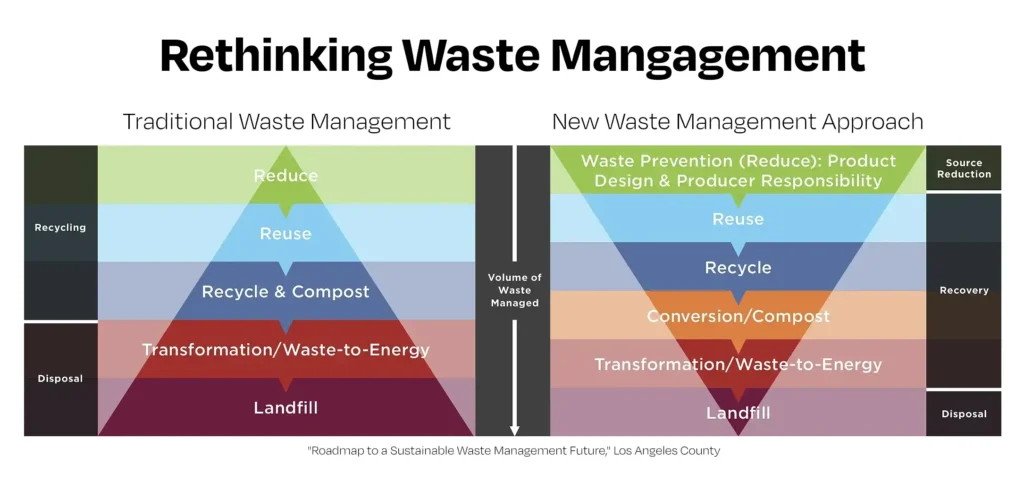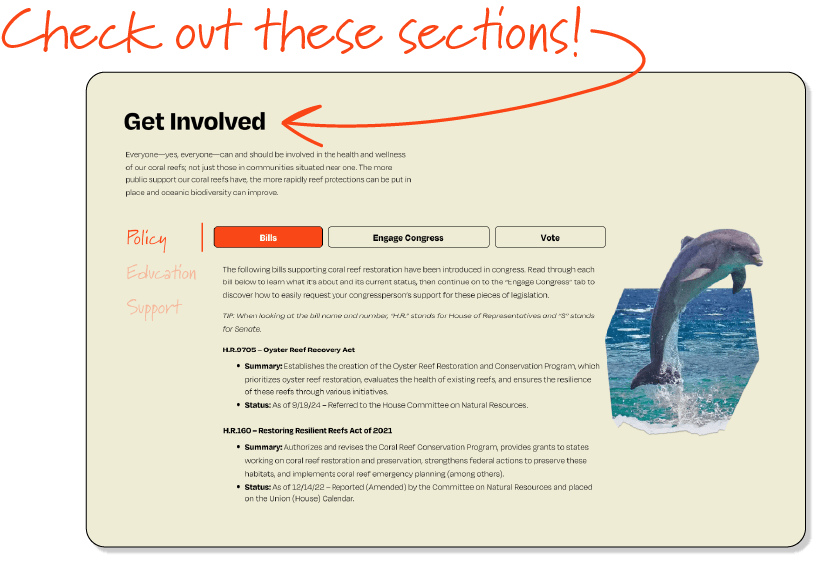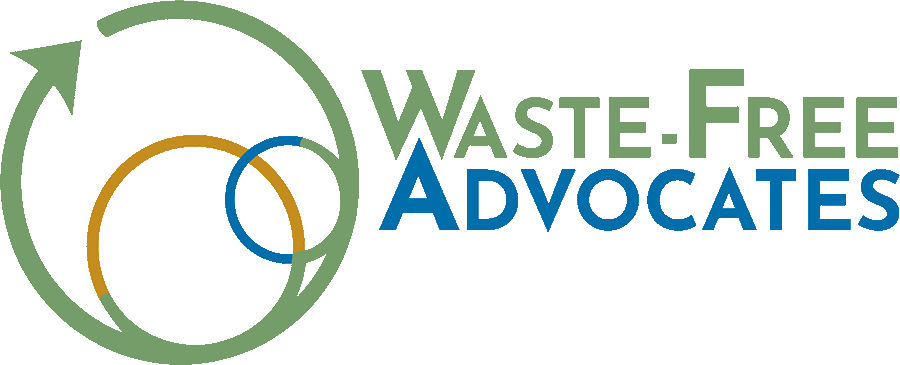SOLUTION
Waste Prevention
Advancing 30×30 goals by preventing waste from entering global ecosystems
Created in partnership with
Waste-Free Advocates
Types of Waste
To understand what waste prevention is, we must first understand the types and sources of waste produced by humans. Some of the most obvious include municipal waste (household and food waste) and sewage. These are the types of waste we create in our everyday lives at home, at work, and at school. Other forms of waste we may not always see in our daily lives include:
Currently, there are four main types of waste management practices. In other words, the four primary ways we “get rid of” the waste human beings regularly create: landfills, incineration, composting, and recycling. Landfilling addresses about 50% of all municipal waste, with recycling at approximately 23.5%, composting at 8.5% (with 6% of food waste being repurposed for things like animal feed and anaerobic digestion), and incineration (for energy) at 12%.1“Global Waste Management Outlook 2024,” United Nations Environmental Program ≫ While recycling and composting may transform waste into another product, that waste is not doing a disappearing act. Even during the incineration process, there is some form of residue remaining from our waste.
It’s important to remember that when we talk about waste management, what we’re ultimately talking about is waste relocation and, in some instances, repurposing. The waste we create ultimately stays with us for a long, long time.
In 2023, 2.1 billion tons of waste were generated worldwide, costing an approximate $252 billion to manage. Without shifting current waste production or waste management practices, this cost is expected to rise to nearly $650 billion by 2050. However, implementing stricter waste prevention could actually lead to a net gain of $108.5 billion based on United Nations modeling.2“Facts and Figures on Materials, Wastes and Recycling,” EPA ≫
Waste Management for Harmful Materials
For some of the more dangerous wastes created, other forms of waste management are required, including underground disposal, ocean dumping, encapsulation, deep-well injection, and surface impoundment.
Essentially, these all follow the same basic premise: dig a hole and bury it. Out of sight, out of mind… right? (IMAGE: Jeff Chormann/Mass. Dept. of Environmental Protection/Flickr)
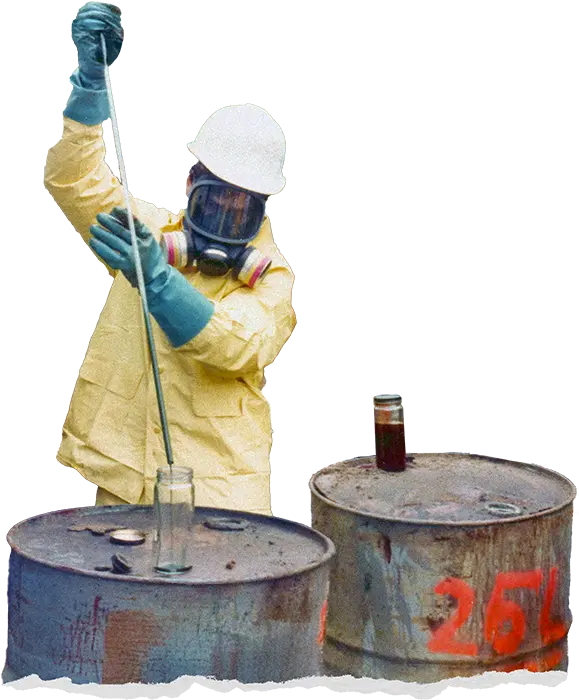
Traditional Indigenous Knowledge
The Ngwa people of Nigeria have no single word or term to describe waste. Instead, there are categories of waste: solids, liquids, degradable, and non-degradable. By identifying the type and source of the waste from the very beginning, the Ngwa can ensure proper disposal—something critical to the health and wellness of the entire community and the plants and animals they rely on for survival. Burying, composting, burning, and mulching (such as recycling items into scarecrows or animal bedding) are all examples of actions that are conducted for multiple benefits. For example, burning rags or fiber sacks under trees can help with pest prevention.3“Harnessing Innovation and indigenous knowledge for Zero waste,” United Nations Develpment Programme ≫
“Local and Indigenous communities…have deep-rooted ancestral and cultural knowledge when it comes to circularity and innovative local solutions. Including their voices, cultures and traditions meaningfully is vital to climate action, the protection of the environment and advancing the circular economy.”
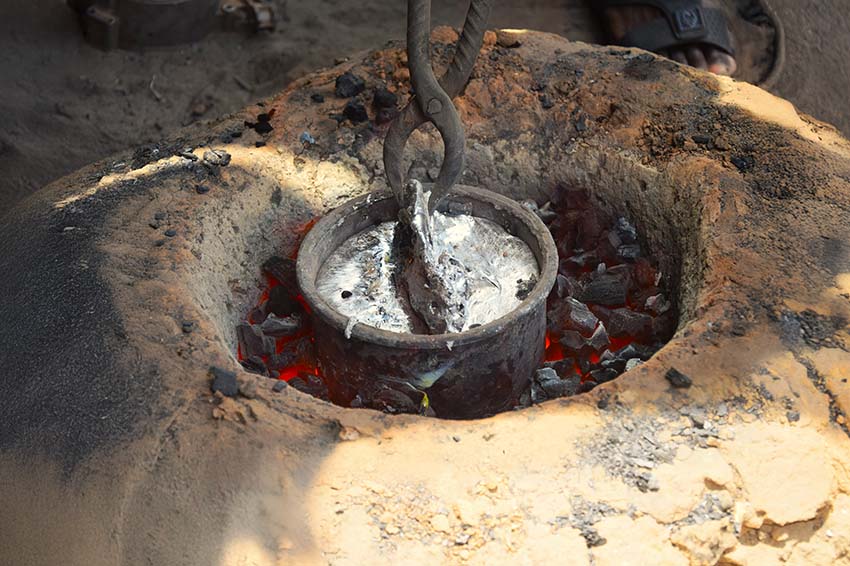
At a marketplace in Nigeria, aluminium is melted in an iron crucible for reuse. (IMAGE: Kambai Akau/Wikimedia Commons)
What is waste prevention?
Unlike management, which mitigates existing waste, waste prevention practices are exactly what they sound like: they reduce the amount of waste created in the first place. This includes using less materials to make products, keeping useful goods in use through recirculation, restoration, and repair before, finally, manufacturing with recycled materials rather than newly mined or pumped raw materials.
Refuse. Rethink. Reduce. Reuse. Recycle. Responsibly dispose.
It’s the three R’s you’re used to, but with a much-needed update! Perhaps it doesn’t quite roll off the tongue, but it’s an important change nonetheless. Reducing what we consume and reusing materials whenever we can must be prioritized before recycling (as we can’t recycle our way out of the climate crisis). But the first and second Rs are arguably the two most important.
We should refuse and rethink. We need to reframe how we see our possessions and refuse what we don’t need. It’s not just a priority for consumers, either. Companies selling disposable, single-use plastics and other non-essentials that fill our landfills should be held accountable for how the waste they produce; particularly companies that use new raw materials to create goods when recyclable materials are available.
And herein lies the concept of the circular economy. The idea is simple: keeping valuable materials in use for as long as possible through regenerative processes that preserve their worth and minimize waste. Ultimately, we need to shift away from today’s culture of waste and normalize reuse.
Waste Prevention and 30x30
In the United States, there are currently 3,000 active and 10,000 inactive landfills. Landfills are necessary for things that cannot be recycled or reused; however, at an average landfill size of 600 acres, we’ve traded more than 1.8 million acres (nearly the size of Delaware and Rhode Island combined) of habitat for garbage.5“The Hidden Damage of Landfills,” University of Colorado ≫
However, we continue to use critical natural resources at unsustainable levels to produce the raw materials needed to create new products. And yet, so many of these same materials—materials that could be reused and repurposed—sit abandoned in our landfills, leaching toxins and harmful gases into our land and air. Here are more examples.
Our lands and waters are directly affected by our waste problem, and entire ecosystems are suffering as a result. If we’re going to protect 30% of each of these critical resources by 2030, we must address waste and waste management and begin to elevate solutions that prevent this waste from being created in the first place.
“20 million metric tons of plastic litter end up in the environment every year. That amount is expected to increase significantly by 2040.”
Waste Prevention and Climate Change
We are now up against what is being coined the “triple planetary crisis.” Our world is facing three interconnected, human-made crises: climate change, biodiversity loss, and pollution and waste.
What about recycling?
Yes, recycling absolutely needs to be part of the solution—but only a small part. We simply can’t recycle our way out of the climate crisis. We don’t have the national or global infrastructure needed to keep up with the amount of waste produced, and many experts suggest recycling as it stands today is far too resource intensive. Meanwhile, a current lack of consistency and education around recycling rules leads to wishcycling, which causes contamination and lost efficiency.
What if we burn our waste? While waste-to-energy has some benefits (reducing waste and producing electricity), it is a transitional solution only and shouldn’t be considered long-term. While it sounds great on the surface, burning waste comes with significant environmental harms and health risks in the form of released gases and particulates.7“Environmental Sustainability Impacts of Solid Waste Management Practices in the Global South,” National Library of Medicine ≫
Ultimately, if we want to tackle the triple planetary crisis head-on and without doing more harm to the planet or ourselves, we must significantly reduce waste, not just find new methods to dispose of it.
Waste Prevention: The Low Down
Learn about the who, where, and when of how we can leverage waste prevention for 30×30 goals.
- The Who
- The Where
- The When
It’s time to steer the world toward a future with less waste, but to do that we need to first acknowledge who can make the most change and what parties (if any) have had the most impact on today’s massive waste problem. Click through the following audiences to learn how each of them has the responsibility and capacity to make change.
Waste management and utility companies are two other groups with significant influence on how our waste is treated. However, as they primarily work in and influence the end of the waste stream, they are far less likely to be able to implement the kind of significant measures we need to reduce the creation of waste. This also means these groups must be considered as part of the solution since their roles will be significantly impacted by changes to the waste stream. We need to consider how we might repurpose these efforts to improve environmental and health outcomes while maintaining integrity in disposal solutions for the waste we do create.
We must also prioritize the involvement of those communities that have already suffered and continue to suffer from waste mismanagement. Particularly, communities where landfills or burn facilities are located, releasing harmful gases into the atmosphere and leachate into the groundwater.
These communities know first-hand what practices are the most harmful and can bring unique perspectives and knowledge to solution development. These communities are also where solution implementation needs to begin.
“Emissions of harmful particulate matter (PM2.5), mercury, and lead from incinerators leads to higher rates of asthma, respiratory disease, and cardiovascular disease… The end result is that low-income and Black, Indigenous, and people of color (BIPOC) communities are most impacted by waste policies and are often targeted by the waste industry and others as potential sites for building incinerators and landfills.”
We need to support on-the-ground work happening in our local communities because this is where we’re going to make the most significant and immediate change. Currently, organizations across America are pushing for a future with reduced waste, circular local and national economies, and sustainably minded waste management systems. (You may not even realize they’re already in your neighborhood!) To learn more about solutions taking place across the U.S., meet six EarthShare Nonprofit Partners making waste prevention a top priority.
Waste-Free Advocates | Portland, Oregon
Waste-Free Advocates connects Portland communities to available reuse/refill resources and education, including waste prevention tips. Learn more >>>
Plant Chicago | Chicago, Illinois
Plant Chicago’s mission is to cultivate local circular economies. Learn more >>>
Boston Building Resources – Reuse Center | Boston, Massachusetts
Boston Building Resources’ Reuse Center takes donations of good-quality building materials that would otherwise be discarded and resells them, giving these materials a second life in the circular economy. Learn more >>>
Clean Water Action | National
Clean Water Action’s reThink Disposable program (currently active in New England, New Jersey, California, and the Upper Midwest) works with businesses, consumers, institutions and events to reduce single-use waste (particularly plastics) and replace throw-aways with sustainable re-use items. Learn more >>>
CCAP | International
CCAP’s Methane Mitigation and Recycle Organics programs work with countries, communities and municipalities around the world to reduce harmful greenhouse gas (GHG) emissions in the waste sector by advancing policies, programs, and projects that ultimately help these countries reduce the waste they produce and achieve a circular and carbon-neutral waste sector. Learn more >>>
Environmental Law Institute | International
Environmental Law Institute (ELI) believes in providing municipalities and state governments with the resources needed to address climate change, promote food security, and eliminate food waste. Learn more >>>
The timeline for implementing and seeing results from better waste prevention and management strategies is hard to pin down. Preventing waste requires looking ahead and reversing our current approach to consumerism. And these aren’t exactly fast processes. For example, putting in place a new municipal recycling program (using the basic standards and practices that currently exist today) can take anywhere from three months to one year. But we’re talking about flipping the waste management triangle on its head, so… It’s going to take a minute. This is why it’s so important that we begin right away.
To help mitigate the waste problem in the meantime, we need to start looking at already-existing waste management practices and consider how these can be transformed into waste prevention. Take school lunch programs, for example. From pumping out food waste (U.S. cafeteria food waste is estimated at about 530,000 tons per year) to becoming zero waste leaders in their communities, school lunch programs across the country have been prioritizing waste reduction and sustainable habits and have achieved a great amount of success doing so.9“Zero Waste Schools,” Seven Generations Ahead ≫
This method shows that waste prevention isn’t about simply reducing our environmental impact, it’s also about saving costs and ensuring nutritional benefits for kids. Programs like these can be happening right now, and the more popular these become, the more momentum we can create to drive positive change.
Get Involved
EVERYONE can help with waste prevention, and strong public support is one of the fastest ways to set change in motion, especially in the face of significant obstacles created by rapidly changing federal policy.
Explore below to learn more!
- Policy
- Education
- Support
- Bills
- Engage Congress
- Vote
The following bills supporting waste prevention have been introduced in congress. Read through each bill below to learn what it’s about and its current status, then continue on to the “Engage Congress” tab to discover how to easily request your congressperson’s support for these pieces of legislation.
TIP: when looking at the bill name and number, “H.R.” stands for House of Representatives and “S” stands for Senate.
S.2889 – NO TIME TO Waste Act | H.R.5657 – NO TIME TO Waste Act
- Summary: Directs the Department of Agriculture (USDA) to address food loss and waste by establishing the Office of Food Loss and Waste and administering education and grants to reduce food loss and waste by 50% by 2030.
- Status: As of 1/11/24 – Referred to the Committee on Agriculture, Nutrition, and Forestry (S). Referred to the Subcommittee on Nutrition, Foreign Agriculture, and Horticulture (HR).
- Similar Bills: S.177 – Zero Food Waste Act | H.R.652 – Zero Food Waste Act | S.1016 – Agriculture Resilience Act of 2023
S.3127 – Break Free From Plastic Pollution Act of 2023 | H.R.6053 – Break Free From Plastic Pollution Act of 2023
- Summary: Amends the Solid Waste Disposal Act to reduce the production of single-use plastics, increase the responsibility of producers, and prevent pollution from entering the environment.
- Status: As of 1/18/24 – Referred to the Subcommittee on Conservation, Research, and Biotechnology (HR). Referred to the Committee on Environment and Public Works (S).
- Similar Bills: S.4194 – Protecting Communities from Plastics Act of 2024 | H.R.8092 – Protecting Communities from Plastics Act of 2024 | H.R.6052 – Recycling Infrastructure and Accessibility Act (passed Senate)
- Summary: Amends the Internal Revenue Code of 1986 to establish a tax on plastics, particularly those made from new raw materials (rather than recycled materials).
- Status: As of 9/22/23 – Referred to the Subcommittee on Environment, Manufacturing, and Critical Materials.
S.1194 – Recycling and Composting Accountability Act
- Summary: Establishes data collection and reporting requirements concerning composting and recycling programs across the United States.
- Status: As of 3/15/24 – Passed the Senate. Held at the desk.
- Similar Bills: H.R.651 – COMPOST Act | S.179 – COMPOST Act
Not sure who represents you in congress? Follow these quick steps to find your congressional representatives and how to contact them:
- Click here and input your home address, then click the search icon.
- Under the name of the representative you want to reach, look for the section titled “Contact.”
- To make a phone call, copy the phone number provided.
- To send an email (or other form of outreach), select the blue hyperlinked word “contact.”
- This will take you to a page with different methods for reaching your representative.
To make the process as simple as possible, we’ve provided you with email and phone call templates. Simply fill in the blanks with your information and then reach out to your representatives!
Your vote means something. It’s your chance to voice your support for the people and policies you think will make a positive difference in your community and across the country.
Register to Vote
Not yet registered to vote? Get started:
It’s super easy! All you have to do is:
- Select the state or territory you live in
- Start your online voter registration
When registering, make sure you have a valid form of identification. This could be your Driver’s License, State ID, and/or Social Security Number.
Find Your Voting Location
Are you a new voter? Have you moved recently? Or maybe you just want to double check you know where you’re going? Find your voting location:
Remind Others to Vote
- Text election reminders to friends and family
- Snap that “I Voted” selfie and share it with the world (this simple act has been shown to increase voter turnout by 4.1%)
- Help others create a voting plan
- Sign up for programs like When We All Vote to help educate others on the importance of voting, important deadlines, and more

- The Issue
- Advocate
- Keep Learning
When it comes to waste prevention, there’s a lot of confusing and sometimes contradictory information out there! It’s more important than ever that we educate ourselves and one another about where waste comes from and the various solutions we have that can address our growing waste problem.
Separating facts from myths when it comes to waste and its disposal (for example, recycling) is a great place to start. By addressing the confusion around recycling and emphasizing the importance of reducing, refusing and reusing into the broader public consciousness, we can begin to make steady progress toward a future with significantly less waste.
Share This Page
Help educate your network of friends, family and followers when you share this page and post about it on social media!
Explore Further
Interested in learning even more about the importance of waste prevention? We’ve compiled a list of key resources to help you move forward on your learning path.
Experts
Meet the professionals fighting for waste prevention throughout the U.S.
Learning Hubs
Dive deeper into the topic with more educational tools.
- Food Waste Reduction | NRDC
- Materials Management – Waste Prevention and Reuse | State of Oregon
- Resources for Waste Diversion and Reduction | U.S. Department of Energy
- Insights Engine | ReFED
- Zero Waste USA – Training, Courses, and Resources | Zero Waste International Alliance
Other Resources
- Workshops | Boston Building Resources

- Nonprofit Limitations
- Donate
- Volunteer
Ask any nonprofit in America (and around the world) what their greatest two challenges are, and they are very likely to say the same things: funding and capacity.
Nonprofits striving to implement and advance waste prevention efforts throughout the U.S. and around the globe are no stranger to this. That’s why your support—be it financial or through volunteer work—makes an enormous difference. By supporting an organization with your time and/or money, you are helping to increase their impact, expand their reach, and make it easier for good to be done for our planet.
Donate to Nonprofits
Meet the vetted EarthShare Nonprofit Partners making a difference for waste prevention and donate to their cause!
- Waste-Free Advocates | Empowering Oregon communities to reduce over-consumption and waste
- Amazon Aid Foundation | Cultivating a cleaner gold supply chain to support a healthier, waste-free Amazon Rainforest
- Boston Building Resources | Reusing building materials for home improvement that’s sustainable and affordable
- Californians Against Waste Foundation | Implementing waste reduction and recycling policies and programs and producer accountability in California
- CCAP | Advancing policies in the waste sector that enable sustainable waste management and methane reduction
- Clean Water Fund | Working with businesses, local governments, and consumers in minimizing single use products
- Plant Chicago | Cultivating local circular economies by equipping people and businesses with the tools to live sustainably
- Rural Action | Helping to build thriving Appalachian communities with zero waste economies
- Zero Waste Washington | Focusing on laws and programmatic changes to reduce waste and save natural resources

- Policy
- Education
- Support
- Bills
- Engage Congress
- Vote
The following bills supporting waste prevention have been introduced in congress. Read through each bill below to learn what it’s about and its current status, then continue on to the “Engage Congress” tab to discover how to easily request your congressperson’s support for these pieces of legislation.
TIP: when looking at the bill name and number, “H.R.” stands for House of Representatives and “S” stands for Senate.
S.2889 – NO TIME TO Waste Act | H.R.5657 – NO TIME TO Waste Act
- Summary: Directs the Department of Agriculture (USDA) to address food loss and waste by establishing the Office of Food Loss and Waste and administering education and grants to reduce food loss and waste by 50% by 2030.
- Status: As of 1/11/24 – Referred to the Committee on Agriculture, Nutrition, and Forestry (S). Referred to the Subcommittee on Nutrition, Foreign Agriculture, and Horticulture (HR).
- Similar Bills: S.177 – Zero Food Waste Act | H.R.652 – Zero Food Waste Act | S.1016 – Agriculture Resilience Act of 2023
S.3127 – Break Free From Plastic Pollution Act of 2023 | H.R.6053 – Break Free From Plastic Pollution Act of 2023
- Summary: Amends the Solid Waste Disposal Act to reduce the production of single-use plastics, increase the responsibility of producers, and prevent pollution from entering the environment.
- Status: As of 1/18/24 – Referred to the Subcommittee on Conservation, Research, and Biotechnology (HR). Referred to the Committee on Environment and Public Works (S).
- Similar Bills: S.4194 – Protecting Communities from Plastics Act of 2024 | H.R.8092 – Protecting Communities from Plastics Act of 2024 | H.R.6052 – Recycling Infrastructure and Accessibility Act (passed Senate)
- Summary: Amends the Internal Revenue Code of 1986 to establish a tax on plastics, particularly those made from new raw materials (rather than recycled materials).
- Status: As of 9/22/23 – Referred to the Subcommittee on Environment, Manufacturing, and Critical Materials.
S.1194 – Recycling and Composting Accountability Act
- Summary: Establishes data collection and reporting requirements concerning composting and recycling programs across the United States.
- Status: As of 3/15/24 – Passed the Senate. Held at the desk.
- Similar Bills: H.R.651 – COMPOST Act | S.179 – COMPOST Act
Not sure who represents you in congress? Follow these quick steps to find your congressional representatives and how to contact them:
- Click here and input your home address, then click the search icon.
- Under the name of the representative you want to reach, look for the section titled “Contact.”
- To make a phone call, copy the phone number provided.
- To send an email (or other form of outreach), select the blue hyperlinked word “contact.”
- This will take you to a page with different methods for reaching your representative.
To make the process as simple as possible, we’ve provided you with email and phone call templates. Simply fill in the blanks with your information and then reach out to your representatives!
Your vote means something. It’s your chance to voice your support for the people and policies you think will make a positive difference in your community and across the country.
Register to Vote
Not yet registered to vote? Get started:
It’s super easy! All you have to do is:
- Select the state or territory you live in
- Start your online voter registration
When registering, make sure you have a valid form of identification. This could be your Driver’s License, State ID, and/or Social Security Number.
Find Your Voting Location
Are you a new voter? Have you moved recently? Or maybe you just want to double check you know where you’re going? Find your voting location:
Remind Others to Vote
- Text election reminders to friends and family
- Snap that “I Voted” selfie and share it with the world (this simple act has been shown to increase voter turnout by 4.1%)
- Help others create a voting plan
- Sign up for programs like When We All Vote to help educate others on the importance of voting, important deadlines, and more

- The Issue
- Advocate
- Keep Learning
When it comes to waste prevention, there’s a lot of confusing and sometimes contradictory information out there! It’s more important than ever that we educate ourselves and one another about where waste comes from and the various solutions we have that can address our growing waste problem.
Separating facts from myths when it comes to waste and its disposal (for example, recycling) is a great place to start. By addressing the confusion around recycling and emphasizing the importance of reducing, refusing and reusing into the broader public consciousness, we can begin to make steady progress toward a future with significantly less waste.
Share This Page
Help educate your network of friends, family and followers when you share this page and post about it on social media!
Explore Further
Interested in learning even more about the importance of waste prevention? We’ve compiled a list of key resources to help you move forward on your learning path.
Experts
Meet the professionals fighting for waste prevention throughout the U.S.
Learning Hubs
Dive deeper into the topic with more educational tools.
- Food Waste Reduction | NRDC
- Materials Management – Waste Prevention and Reuse | State of Oregon
- Resources for Waste Diversion and Reduction | U.S. Department of Energy
- Insights Engine | ReFED
- Zero Waste USA – Training, Courses, and Resources | Zero Waste International Alliance
Other Resources
- Workshops | Boston Building Resources

- Nonprofit Limitations
- Donate
- Volunteer
Ask any nonprofit in America (and around the world) what their greatest two challenges are, and they are very likely to say the same things: funding and capacity.
Nonprofits striving to implement and advance waste prevention efforts throughout the U.S. and around the globe are no stranger to this. That’s why your support—be it financial or through volunteer work—makes an enormous difference. By supporting an organization with your time and/or money, you are helping to increase their impact, expand their reach, and make it easier for good to be done for our planet.
Donate to Nonprofits
Meet the vetted EarthShare Nonprofit Partners making a difference for waste prevention and donate to their cause!
- Waste-Free Advocates | Empowering Oregon communities to reduce over-consumption and waste
- Amazon Aid Foundation | Cultivating a cleaner gold supply chain to support a healthier, waste-free Amazon Rainforest
- Boston Building Resources | Reusing building materials for home improvement that’s sustainable and affordable
- Californians Against Waste Foundation | Implementing waste reduction and recycling policies and programs and producer accountability in California
- CCAP | Advancing policies in the waste sector that enable sustainable waste management and methane reduction
- Clean Water Fund | Working with businesses, local governments, and consumers in minimizing single use products
- Plant Chicago | Cultivating local circular economies by equipping people and businesses with the tools to live sustainably
- Rural Action | Helping to build thriving Appalachian communities with zero waste economies
- Zero Waste Washington | Focusing on laws and programmatic changes to reduce waste and save natural resources

Where to Start
We’ve curated a list of nonprofits doing work with waste prevention in the United States and around the world. Learn more about the incredible work they’re doing and show your support.
Check out these orgs!
Waste-Free Advocates* | Empowering Oregon communities to reduce over-consumption and waste
Amazon Aid Foundation | Cultivating a cleaner gold supply chain to support a healthier, waste-free Amazon Rainforest
Boston Building Resources | Reusing building materials for home improvement that’s sustainable and affordable
Californians Against Waste Foundation | Implementing waste reduction and recycling policies and programs and producer accountability in California
CCAP | Advancing policies in the waste sector that enable sustainable waste management and methane reduction
Clean Water Fund | Working with businesses, local governments, and consumers in minimizing single use products
Plant Chicago | Cultivating local circular economies by equipping people and businesses with the tools to live sustainably
Rural Action | Helping to build thriving Appalachian communities with zero waste economies
Zero Waste Washington | Focusing on laws and programmatic changes to reduce waste and save natural resources
* EARTHSHARE 30×30 PARTNER
Created as part of the Mosaic 2023 Movement Infrastructure grant program
Share your thoughts on The 30×30 Project website
©2025 EarthShare. All rights reserved. EarthShare is a registered 501(c)(3) nonprofit.
